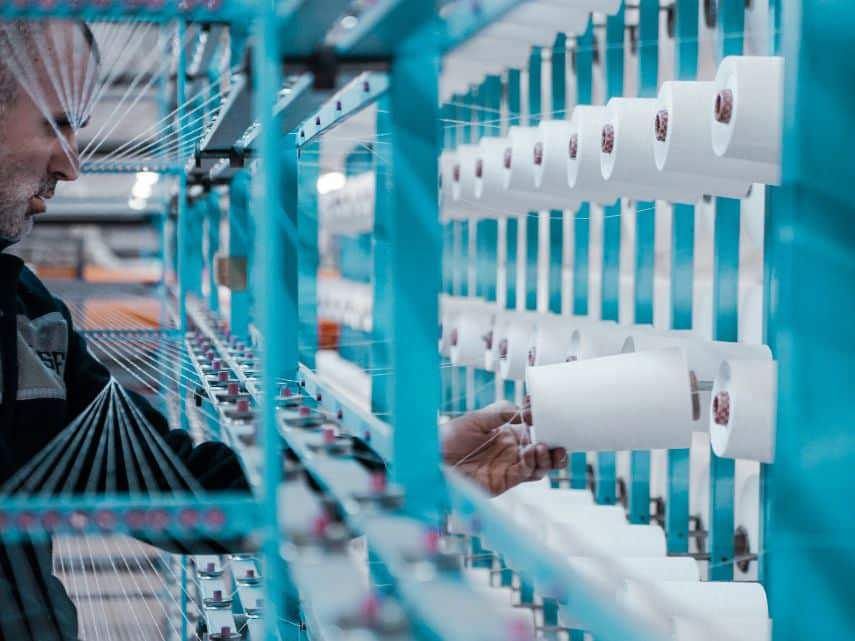
As a manufacturer, a lot of businesses and customers rely on you to get things done on time.
But when your cash is locked up in wages, managing inventory, lines of credit, and other costs, it can slow down productivity – even bring it to a standstill. And if you’ve got no way to pay the bills or order new parts, you might have to shut up shop for good.
So, let’s break down how to improve cash flow in a manufacturing business and look at the various cash flow challenges faced by manufacturers around the world.
 Accessible cash flow is critical for avoiding liquidation and staying profitable as a manufacturer.
Accessible cash flow is critical for avoiding liquidation and staying profitable as a manufacturer.
Common manufacturing cash flow challenges
Cash flow is like gasoline for manufacturers – it’s what empowers your business to get from A to B. When your cash is all tied up in debt, assets, and overheads, you’re left with nothing to spend on new parts and production (or vice versa).
This can lead to company losses, unhappy customers, and, eventually, insolvency.
As the owner or operator of a manufacturing business, you need to be prepared for potential future obstacles. So, let’s quickly cover a few of the common cash flow challenges manufacturers face when financing a business.
The cost of production outweighs your sales margins
If the cost of producing a product outweighs the return it generates through sales, your manufacturing business will start to bleed cash. Similarly, when the cost of production is equal to the return your business growth can stagnate.
Without an accurate grasp of production costs and how they relate to sales throughout different periods, you may never realise that the products you think are selling well are some of your biggest laggards.
Production lead times aren’t profitable
The moment that you purchase raw materials, you also lock access to all that capital.
The promise at the end of the rainbow is that there’s a profitable return to come once you’ve used those materials to build and sell more products. But if your assembly lead times are too slow, you can end up strapped for cash much longer than desirable.
All that cash locked up in raw materials and production may prevent you from making key investments and result in cancelled customer orders and refunds.
 Slow production times can result in too much cash committed to parts and assemblies.
Slow production times can result in too much cash committed to parts and assemblies.
You’re holding too much inventory
Too much stock on hand at a given moment turns cash into slow-moving stock.
This can often be the result of inaccurate min/max levels, a change in customer demand, or economic uncertainty. To liquidate these assets requires significant effort and the potential for loss of profit. It also puts up the risk of financial loss in the form of shrinkage and spoilage.
All your cash is tied up in credit
You may be tempted to extend generous lines of credit and show leniency with your clients as a way of building good relationships.
But the more generous you are with customer credit, the less your business profits. Customers receiving goods without paying on time adds extra time between purchasing manufacturing inventory and getting your due return. In other words, it leaves you with no cash to spend until they pay.
- Learn more: Common Cash Flow Problems & How to Solve Them
How to improve cash flow in a manufacturing business: 7 strategies for healthier financials
Improving cash flow is a crucial part of finding success as a manufacturer.
The benefits of healthy cash flow are numerous – happier customers, better manufacturing productivity, and broader margins to name but a few. But first you have to get in the green.
The following cash flow tips and strategies for manufacturers will help you build a clearer picture of your finances and generate better cash flow for your business.
1. Gain more business visibility
The first step towards fixing your manufacturing cash flow problems is to gain a complete understanding of your business health.
By using modern manufacturing software and technology solutions, you can create greater visibility over the manufacturing pipeline and other aspects of your business. This will help you identify where you’re bleeding the most cash.
Better business visibility can be achieved by investing in a best-of-breed software package.
This ideal manufacturing best-of-breed software stack looks something like:
- Manufacturing inventory management software that provides real-time visibility of every aspect of your business from the supply chain through to freight, including stock levels, lead times and material costs.
- Accounting software, such as QuickBooks or Xero, helps you track income and expenses, and compare dollar figures to product information.
- Customer relationship management (CRM) software with inventory management integration, such as Prospect or Salesforce, that keeps track of the most important info relating to your customers, which can be used for sales, marketing and customer service.
 Manufacturing inventory management software helps to automate your processes and offers improved vision over your financial health.
Manufacturing inventory management software helps to automate your processes and offers improved vision over your financial health.
2. Get paid quicker
The timeliness of receiving money owed to you can often be beyond your control.
That’s why it’s essential to reduce the opportunity for delays and avoid giving credit to untrustworthy customers. Consistent follow-ups and harsher screening around which customers you offer lines of credit can prevent a lot of problems later.
But that’s not all you can do about it.
Here are a few more tactics for reducing the time it takes customers to pay you:
- Send your invoices quicker: The faster your company sends invoices for goods, the faster someone can turn around and pay them.
- Get good at following up: It can be awkward to chase people up for payments, especially if you like them. But it’s a part of doing business, and if someone isn’t paying on time, you need to bring it up. Remember: phone calls are typically more effective than sending an email.
- Incentivise early payments: Make it in your customers’ best interests to pay you back earlier than normal. You can do this by offering incentives such as reduced shipping costs or bulk discounts.
- Offer multiple payment options: When customers have to use your preferred system instead of theirs, they can be more reluctant to pay. The more methods of payment you accept, the more willing and able your customers will be to pay you on time.
- Don’t sell to customers who don’t pay: Don’t let someone take advantage of you – stop giving credit out to customers that don’t pay on time. It doesn’t matter if they’re a friend of yours; if they’re not loyal to your agreement, you don’t owe them any loyalty in return.
- Sell the debt: If you’ve come to a dead-end chasing money that’s owed to you, it might be time to give your local debt collection agency a call. Alternatively, you can sell the debt to a debtor finance lender.
While credit makes it easier for people to pay you back, it’s not worth going broke over.
It may even be time to stop giving out credit entirely – or at least until you’ve built bigger cash reserves. Lines of credit are a privilege for customers, not something they’re entitled to. If a late payment could run your business into the ground, don’t take the risk.
3. Reduce excess expenses
Contrary to popular belief, sometimes you need to save money to make money.
Trimming the fat from the budget and freeing up cash flow to spend on growth can be achieved by implementing a lean manufacturing approach to running your business.
This means cutting out unnecessary expenses and lowering the cost of anything you can’t eliminate outright.
A few fast ways to reduce the cost of your regular business expenses:
- Compare supplier prices and procure better deals for stock and consumables.
- Seek cheaper storage facilities with lower utility costs.
- Recycle waste – if unused assemblies can be economically broken down for parts or an old box can be reused for shipping an order, take advantage of the opportunity.
- Lower production and fulfilment expenses by implementing automated processes that increase accuracy and productivity.
- Consider switching to Just In Time Manufacturing until you can afford to hold more stock..
You should have an idea of which expenses are hurting your cash flow the most. Prioritise reducing these first, as they’ll have the most beneficial impact once reduced.
4. Sell your excess stock
Getting rid of surplus stock is a great way to reduce your storage costs and build up more free cash. You can do this by selling the extra products at a discounted bulk price or throwing a sale.
Consider the losses that these reductions will have for your business, and balance them against the costs of tied-up cash flow and extra storage costs. Does the cost of inventory storage outweigh the short-term loss in selling it all off?
Sometimes losses must be made so you can remain afloat. Use any metrics you have at your disposal to get the most accurate forecast of potential losses before you start selling the extra stock.
- Learn more: The 5 P’s of Inventory Shrinkage
 Strike while the iron is hot: Selling excess stock is an effective short-term strategy for improving cash flow in a manufacturing business.
Strike while the iron is hot: Selling excess stock is an effective short-term strategy for improving cash flow in a manufacturing business.
5. Reassess your supply chain
Irrespective of how you run your business, if your suppliers are gutting your budget (whether they intend to or not) then you may need to look for a new deal.
Hunting for a new deal doesn’t necessarily mean changing suppliers, but it does mean going back to the negotiating table to seek better terms.
If you’ve got a good relationship with a specific vendor, consider asking them for:
- Extended credit terms
- Lower minimum quantities
- Bulk discounts or better prices
Just like you, suppliers want to work with customers they can trust will pay them on time and regularly. If you’ve already proven your loyalty to a certain vendor, this is simply asking for them to return that loyalty by providing more acceptable sales conditions.
6. Consider equipment upgrades
If you’re stressed about cash flow, the idea of spending lots of money on new equipment may seem counterproductive. But in many cases, upgrading your equipment can save you a fortune long-term.
Old equipment is often slower, less capable, and less efficient. This results in wasted staff time and slower production processes. Add to that the fact many old machines draw large amounts of energy, raising your utility costs, and are often pricey when it comes to maintenance.
The solution is to calculate how much it costs to operate each piece of equipment in your process, including maintenance and power bills, for an entire year. Compare this to the price of upgrading or replacing the equipment, and how much that will save in a year.
If it’s profitable and won’t destroy your cash flow in the short term, this is a highly sustainable manufacturing cash flow solution that will pay dividends further down the track.
7. Reassess your pricing
Sometimes all that needs fixing is how much you’re selling the goods for.
Pricing is an art form and a science, and it’s easy to misjudge if you’re basing business decisions on gut feel and market experience alone. Evidence-based decision-making, achieved with real-time data from an inventory management platform, will tell you the information you need.
Use real-time data about your business to determine:
- Which of your products have the best returns
- Which of your products have the worst returns
- Which products are “loss leaders” – items that have a poor ROI but often lead to customers buying additional products
There’s a good chance you’ll discover that the items you thought were your VIPs are in fact dragging you down because, despite plenty of sales, their margins are razor thin.
Once you’ve got a clearer understanding of how much money each product is making you, adjust your pricing to bring those margins up.

